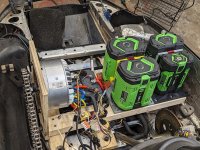Reviewing an hour long video from Utube channel "Thrifty Tool Shed", the link will be provided at the end of this posting. He actually takes the EGO BMS board and repairs it. It is a far more complex board than I expected, lots of components on this board. So we're not just looking for a simple BMS chip. He figures out some interesting things in his troubleshooting process. Some things he says don't seem to be completely accurate, so regard each comment carefully.
I do see the primary current conductors going to the main connector PC Board, but I also see a number of small conductors going to that board. So I cannot rule out that there is some additional circuitry on that board, as the number of small conductors was more than four, so that would indicate something more on that board than just the four connector pins. More questions. Perhaps they are redundant wires. Perhaps they have temperature sensing on this battery connector.
There is a clock/calendar chip on the board PCF85163T, this is perhaps how they do the 30 day timing without consuming much power.
There are two somewhat proprietary microcontrollers. A DC converter to power the circuits from the battery.
The battery LED flashing green every 2 seconds and the battery end getting warm indicates that the processor induced 30 day discharge cycle is going on, according to the troubleshooting chart in the manual.
A transistor, MJD117 was shorted on his BMS, he replaced it and this seemed to fix it, however his cells had been drawn very low so they may also have suffered some damage.
video:



